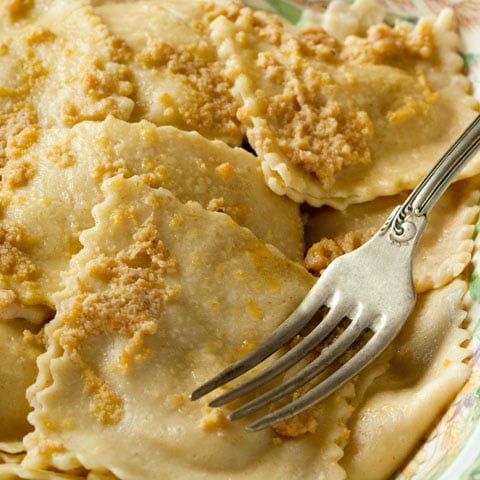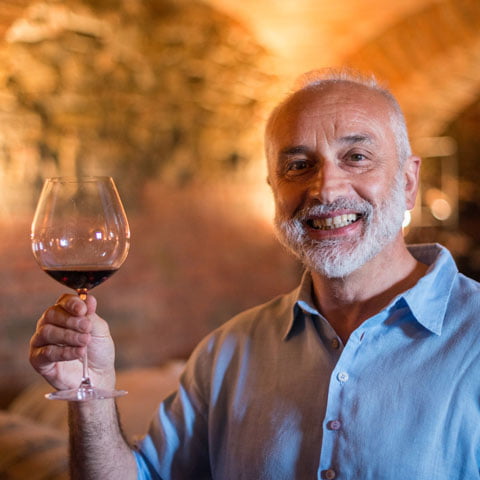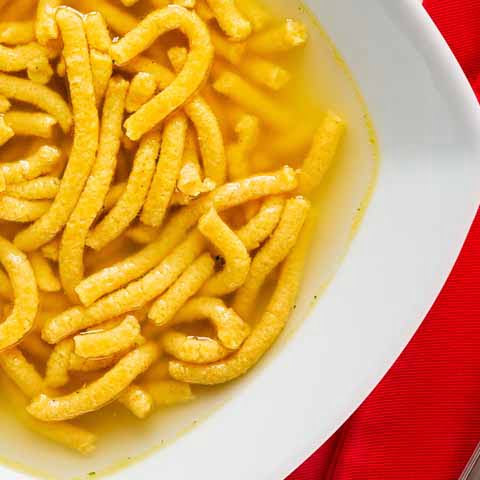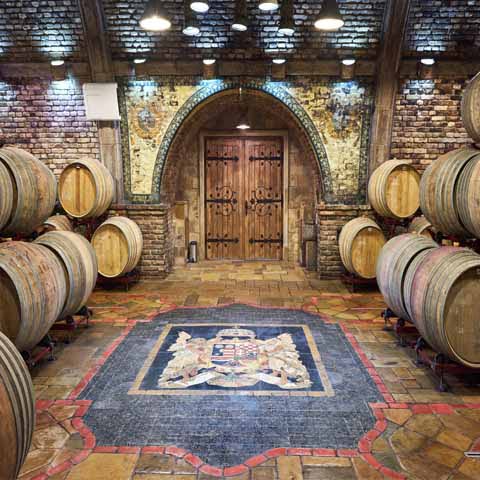Like other cities throughout Piedmont, Casale Monferrato values cuisine and wine, as they are a key aspect of the town’s economy and reflect the history and culture of the area. Piedmont cuisine is notably different from other regions throughout Italy, featuring filling meats, rich flavors, and decadent ingredients such as goat cheese, red wine, and truffles.
Travelers to Italy can enjoy local cuisine at neighborhood bars, street side cafés, and elegant restaurants. The town also has a variety of food themed events and festivals throughout the year.
On the second Sunday of each month, Casale Monferrato’s Piazza Castello hosts a farmer’s market that celebrates the food of the area. Reserved exclusively for local agricultural producers from in and around Casale Monferrato, the market features a wide variety of local food products such as wines, cheeses, produce, meat, and more.
In September, the rice harvest season is celebrated in conjunction with the wine harvest during a food and wine festival. There, travelers can taste a variety of local products from sausages to desserts to wine.
APPETIZERS
When visiting Casale Monferrato, travelers can expect to find traditional Piedmontese appetizers, such as bagna càuda and fassona tartare. Bagna càuda is a fondue-like appetizer made of garlic, olive oil, and chopped anchovies, which is used as a dip for vegetables. Fassona, a breed of cattle that is specific to the region of Piedmont, is often served raw in an appetizer. Seasoned simply – often with only olive oil, salt, and pepper – the dish is unusual for those who have never tried it, but simply delicious.
Another delicious appetizer is fritto misto, which consists of vegetables and seafood that are dipped in a light batter and fried extra crispy.
FIRST COURSE
The king of pasta dishes for the first course in Casale Monferrato and other areas in Piedmont is agnolotti, ravioli-like pieces of pasta stuffed with meat. The origin of the dish goes back to old times in the Italian countryside when women would utilize leftover meat from the day before to prepare food for the next day.
In addition to other varieties of pasta, the first course in Casale Monferrato can also include soups, potato gnocchi, and risotto dishes.
One type of risotto favored by the locals is risotto al Castemagno e nocciole. The two main ingredients — Castelmagno cheese and hazelnuts — both hail from the Piedmont region.
SECOND COURSE
Piedmont is known for its meat-heavy, rich-tasting cuisine. Travelers can expect second-course meals in Casale Monferrato to be filled with meats such as beef and wild game, locally grown vegetables, and mushrooms. A local delicacy in the region are white truffles, a flavor commonly found throughout savory dishes.
Many of the common meat dishes, such as roasts or stews, often highlight the flavors of the region’s rich, full-flavored, red wines. Piedmont’s meat is considered to be among the most high-quality meats in all of Italy.
One common second course dish in Casale Monferrato and other wine-producing areas in Piedmont is brasato al Barolo. The dish consists of a fassona beef stew made by cooking the meat with Barolo wine, vegetables, such as onions and carrots, and herbs.
SIDE DISHES
Common vegetables featured in local side dishes include peppers, cardoons, and leeks.
STREET FOOD
The area’s signature pasta, agnolotti, may be served in a bowl and enjoyed on the go. Casale Monferrato also hosts a street food festival in Piazza Castello that showcases national and international street foods.
DESSERT
The signature dessert dish of Casale Monferrato are krumiri, Italian biscuits (or cookies) made from a recipe that is nearly 150 years old.
A delicacy of Casale Monferrato, krumiri were said to have been created by Domenico Rossi in the 1870s. His recipe is the first noted recipe of the dish ever found. The shape of the cookies – a cylinder that has been bent into a half-moon or handlebar shape – is said to have been Rossi’s way of paying homage to King Vittorio Emanuelle II and his famous mustache.
These local delicacies are made with wheat flour, sugar, butter, eggs, and vanilla. They are made without preservatives or water, so the texture of the cookies is crunchy, making them perfect for dipping into hot coffee or tea. Similar to biscotti, these dark colored biscuits are often enjoyed after a meal either with a hot beverage or a glass of dessert wine or liqueur. In fact, krumiri were named after a popular liqueur of the time.
Krumiri are such a well-loved Casale Monferrato classic that there is a dedicated shop that solely produces krumiri. Owned by the same family since the 1950s, the pastry shop makes all of the krumiri by hand and sells them all over the world. They keep their production level relatively low, despite the dessert’s popularity, in order to keep up the traditional standards and integrity of the cookie’s hundreds of years of history. Krumiri have even been offered by the Italian delegation to the President of the United States.
Various pastry shops throughout town serve traditional Piedmontese and Italian desserts such as amaretti and finocchini cookies, torta di nocciola (hazelnut cake), and various pastries.
Brutti ma buoni are another type of cookie that is characteristic of the Piedmont region. The cookies are made with hazelnuts and egg whites. The name, which translates to “ugly but delicious”, derives from the irregular and rough appearance of the cookies, which is overshadowed by the remarkable flavor.
WINE
The climate and land of the Monferrato area is ideal for growing grapes. Between the weather – which is relatively dry throughout the year with hot summers and cold winters, the mineral-rich soil, and the longstanding tradition of viticulture, Monferrato has solidified itself as one of Italy’s most famous and highly productive wine regions.
Many grapes are indigenous to the area and as a result, a variety of unique and delicious wines can be created. In Monferrato, there are more than 300 wine producers, earning the area the name “The Land of Wine.” Winemaking is as much a part of family and tradition in Monferrato as it is an economic success.
When visiting Casale Monferrato, travelers are in the heart of Italian winemaking, as the city was the birthplace of Senator Paolo Desana, also known as the “father of DOC.” DOC is a term used to describe the quality and authenticity of wine that is now the standard for helping to determine the value of high-quality wine.
Typical Monferrato wines include Barbera (a full-bodied red), Cortese (medium-bodied white), Barbera and Barbaresco (reds made from the Nebbiolo grape), Moscato and Asti Spumante (sparkling whites), and Casale Monferrato’s own Grignolino Monferrato Casalese (a red wine that is known for its unexpected taste).
Casale Monferrato’s DOC wines are very well-received, and its easy to see why. The rolling hills and stunning vineyards, the traditional wineries, the experienced farmers – there is so much of the area that is rooted in wine culture.
During September, wine is celebrated in a major way at the annual Festival of Wine and the Monferrato. This festival celebrates harvest season in the Monferrato area, concluding a year of hard work for the local growers. Held in the Pavia Market in Piazza Castello, food and wine are featured via tastings and exhibitions. The event also includes musical performances, markets that sell wine and local products, and more.
Throughout Casale Monferrato, wine lovers will find that every glass is filled with the passion and quality that is to be expected of the Monferrato area’s reputation.
Casale Monferrato, located in Italy’s Piedmont region, is recognized worldwide for its eminent wines. Travelers to Casale Monferrato should not miss the opportunity to pair the area’s wines with local specialties such as agnolotti, brasato al Barolo (which is made with wine), and krumiri.Travel Guides
The Piedmont Region of Italy
The Cities of Piedmont, Italy










